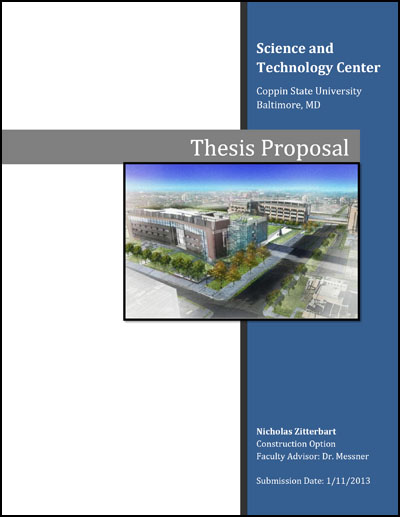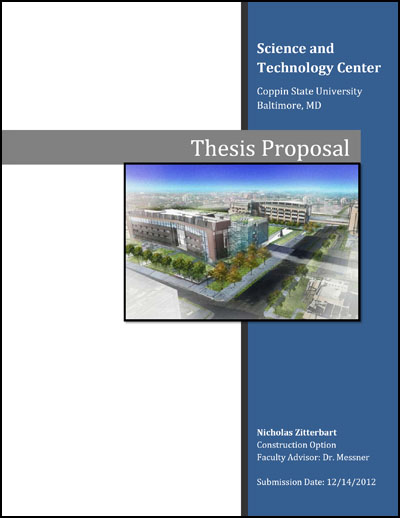Science and Technology Center
Coppin State University │ Baltimore, MDNicholas Zitterbart
Construction Management

Thesis Proposal |
||||||||||||
Breadth Topics Structural Breadth [Incorporated into Analyses 2 and 4] The modular curtain wall system, as detailed in Analysis 2, provides an opportunity to apply research and analysis outside of construction management areas. This system will incorporate steel connections to the CIP concrete slabs in order to support the modular curtain wall panels. A further investigation into steel connection types, capacities, and tolerances will yield a better design choice for this new modular system. The constructability of these steel connections will heavily rely on the design choice and the integration with the panels. This could also include the possibility of adding additional bracing to support panels between structural bays as the panel size may be limited by transportation methods. In addition, the waterproofing of the panels is critical to the success of the curtain wall system. These issues will need to be further reviewed to pinpoint erection and installation sequences. A structural breadth is also incorporated into the alternate foundation system, as detailed in Analysis 4. This alternative system (potentially drilled micropiles) includes a change of design for foundation support. Proper bearing capacity and building loads will need to be considered with the new system. From a constructability perspective, this system can analyzed in terms of construction sequence and provide evidence of schedule savings. This will contribute to the overall goal of reducing the schedule and delivering the project within the original timeline. Mechanical Breadth [Incorporated into Analysis 3] The current mechanical system involves multiple fin tube radiators along the window lines in the spaces. There is significant installation time due the labor intensive connections with each unit. To contribute to schedule savings, an alternative for this system is to include linear diffusers at the ceiling height in lieu of the fin tube radiators. A University of Maryland standard is to deliver air at the same temperature at both the window line and inside the space to provide more thermal controllability. Analysis 3 will focus on providing these linear diffusers at beneficial locations throughout the building, as opposed to replacing all of the radiator units. This will be dependent upon the total load on the system and how it can be provided. By reducing the number of fin tube radiators, the total heating load on the boilers will be reduced. This heating load will then be used to design the air handling unit size. As part of the analysis, it will be determined which areas (small or large) will benefit the most from this change (cost per unit of energy supplied in each system). In constructability terms, this alternative will then be evaluated for cost effectiveness and reduction in schedule as a result of labor time/cost changes. MAE Requirements These analyses will be aided by the knowledge gained in graduate level courses from the MAE curriculum. The courses that will be referenced include AE 570 [Production Management in Construction] and AE 572 [Project Development and Delivery Planning]. Information from AE 570 will be give support to Analyses 1 and 2 with a focus on production tracking and methods. In terms of the schedule resequencing, production principles in lean construction such as Last Planner, pull/flow production, and SIPS can lend to more effective planning methods. If it is deemed that a resequence is inefficient, then these production methods could be applied to this project. Case studies and research will support the implementation of these principles and provide advantages of each method. In addition to these production methods, the modularization of the curtain wall system will also apply to the AE 570 course. A research project was conducted involving the many aspects of modular construction and the potential benefits to a project schedule. The information from this class will help support the implementation of the analysis areas. AE 572 provided information that will support Analysis 1 of this proposal. This course focused on scheduling and planning methods that result in a more efficient design and construction process. The schedule resequence analysis will focus on information gained from this class in respect to scheduling methods. The current CM-at-Risk delivery method will not be modified, more so the information gathered from the course will contribute to the overall theme of schedule reduction scenarios.
|
||||||||||||
Note: While great efforts have been taken to provide accurate and complete information on the pages of CPEP, please be aware that the information contained herewith is considered a work‐in progress for this thesis project. Modifications and changes related to the original building designs and construction methodologies for this senior thesis project are solely the interpretation of Nicholas Zitterbart. Changes and discrepancies in no way imply that the original design contained errors or was flawed. Differing assumptions, code references, requirements, and methodologies have been incorporated into this thesis project; therefore, investigation results may vary from the original design.

